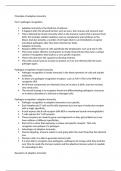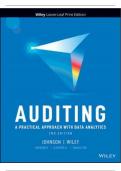Lecture notes
principles of adaptive immunity
- Module
- Mechanisms of pathology
- Institution
- Aston University, Birmingham (Aston)
• Adaptive immunity is the third line of defence. • It happens after the physical barriers such as tears, skin mucous and stomach acid. • This is followed by innate immunity which is the immune system that is present from birth, this includes soluble mediators such as complement and cytokin...
[Show more]




